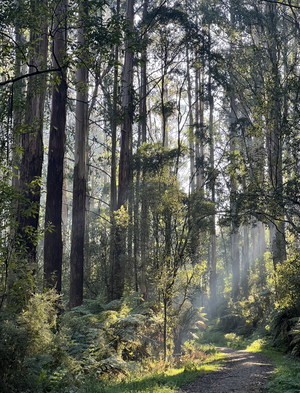
Live stream: dandenongranges_oz.mp3
Eastern Highlands, Victoria, Australia
Laurent Labourmene
Latitude: -37.887394775258805°
Longitude: +145.3778647597608°
A wet sclerophyll forest in the Dandenong Ranges National Park, Victoria, approximately 40km from Naarm (Melbourne’s) CBD.
This stream is stewarded by Laurent Labourmène ( www.laurentsl.com ) and is gratefully supported by Soundcamp.
This stream is stewarded by Laurent Labourmène ( www.laurentsl.com ) and is gratefully supported by Soundcamp.
My avian collaborators and I are broadcasting from a wet sclerophyll forest in the Dandenong Ranges National Park, Victoria, Australia, approximately 40 km from Naarm (Melbourne’s CBD).
A defining feature of this location is the presence of remnant Mountain Ash trees, among the world's tallest flowering plants — growing over 100 metres high and living up to 500 years. The area is also home to many bird species, including one of the planet's largest and most iconic songbirds: the Superb Lyrebird (menura novaehollandiae). This is one of two species in the Menuridae family, the other being the lesser-known and more elusive Albert's Lyrebird (menura alberti), found in a small area along the border of New South Wales and Queensland, where I’ve been conducting field recordings over the past 5 years.
BirdLife Australia estimates that around 40 per cent of the Superb Lyrebird’s habitat was destroyed in the 2019–20 Australian megafires, casting doubt on the species’ conservation status. With Dr Alex Maisey from La Trobe University as my guide, I visited a forest in the Dandenong Ranges that is home to multiple Superb Lyrebirds. Dr Maisey’s doctoral research revealed that this extraordinary songbird is also one of the planet's great ecosystem engineers — changing the environment in ways that affect many other species. This amazing being of the Earth can move more soil than any other land animal. According to Alex, “In just one year, we calculated that each lyrebird... moved a load equivalent to that carried by 11 standard dump trucks.”
As we approach the Superb Lyrebird’s mating season (June to October), we may be lucky enough to hear their impressive mimicry — a medley of local avian life including Whipbirds, Currawongs, Kookaburras, Grey Butcherbirds, King Parrots, Red Wattlebirds and more. This small pocket of the Dandenong Ranges National Park is nestled between several roads and has become a popular weekend destination for cyclists, bushwalkers and tourists. During my recent field trips, sirens, cars, motorbikes, planes and the voices of people often were often heard echoing through the forest, intermingling with the songs of birds.
Acknowledgments
This broadcast unfolds on Wurundjeri Woiwurrung country. As a migrant settler here, I extend my deep respect to the traditional custodians of these lands and waters, and to their millennia-long, intergenerational practices of culture, storytelling, science and care for Country.
This stream is stewarded by Laurent Labourmène ( http://www.laurentsl.com ) and is gratefully supported by Soundcamp.